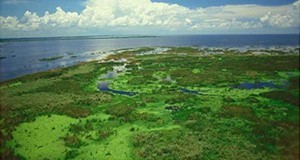Abstract
Future climate change could result in higher temperatures and greater evaporative water loss in Florida. If these changes are not compensated for by more rainfall, the state’s largest water body, Lake Okeechobee, could experience prolonged periods of very low water levels and catastrophic loss of its ecosystem services, which are the benefits that people receive from ecosystems. This 7-page fact sheet provides background, optimal and actual water levels, projected changes in South Florida climate and their effects on water levels in Lake Okeechobee, their effects on ecosystem services, and possible remedies. Written by Karl Havens, and published by the UF Department of Sea Grant, June 2015.
References
Aumen, N.G., and R.G. Wetzel. 1995. Ecological studies on the littoral and pelagic systems of Lake Okeechobee, Florida (USA). Archiv für Hydrobiologie, Advances in Limnology, 45, 356 pp.
Havens, K.E. 2002. Development and application of hydrologic restoration goals for a large subtropical lake. Lake and Reservoir Management 18: 285-292. https://doi.org/10.1080/07438140209353934
Havens, K.E. 2007. Phosphorus dynamics at multiple time scales in the pelagic zone of a large shallow lake in Florida, USA. Hydrobiologia 581: 25-42. https://doi.org/10.1007/978-1-4020-6158-5_4
Havens, K.E., N.G. Aumen, and V.H. Smith. 1996. Rapid ecological changes in a large subtropical lake undergoing cultural eutrophication. Ambio 25: 150-155.
Havens, K.E., and A.D. Steinman. 2015. Ecological responses of a large shallow lake (Lake Okeechobee, Florida) to climate change and future hydrologic regimes. Environmental Management 55:763-775. https://doi.org/10.1007/s00267-013-0189-3
Hodges, A.W., and J.J. Haydu. 2003. Economic impacts of drought on the Florida environmental horticultural industry. University of Florida Institute of Food and Agricultural Sciences, Gainesville, FL. http://edis.ifas.ufl.edu/fe385. https://doi.org/10.32473/edis-fe385-2003
Obeysekera, J., J. Barnes, and M. Nungesser. 2015. Climate sensitivity runs and regional hydrologic modeling for predicting the response of the greater Florida Everglades ecosystem to climate change. Environmental Management 55: 749-762. https://doi.org/10.1007/s00267-014-0315-x
SFWMD. 2005. Documentation of the South Florida Water Management Model Version 5.5. South Florida Water Management District, West Palm Beach, FL.
Steinman, A.D., K.E. Havens, and L. Hornung. 2002. The managed recession of Lake Okeechobee, Florida: integrating science and natural resource management. Conservation Ecology 6 (2), Online https://doi.org/10.5751/ES-00417-060217

